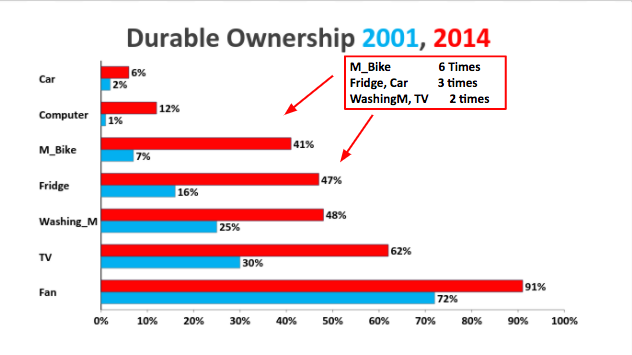my2cents
SENIOR MEMBER

- Joined
- Apr 8, 2011
- Messages
- 5,631
- Reaction score
- -9
- Country
- Location
The hidden truth behind India’s low refrigerator ownership
http://blogs.economictimes.indiatim...uth-behind-indias-low-refrigerator-ownership/
Nearly 90% families in China today have a refrigerator. What about India?
The 2016 ICE 360° survey showed that a little less than 30% of Indian families have a refrigerator. At first glance, we may conclude that a fridge is still an aspirational product that doesn’t fit into the majority of Indian families’ budgets. That reasoning however, does not hold up.
The same survey showed that even in the top 20% of the richest Indian families, only six out of 10 families have a fridge. This suggests that constraints other than affordability are at work here that influence households’ decision to buy a refrigerator.
While a threshold level of income is a necessary condition for the purchase of a refrigerator, it is not the sufficient condition.
The 2011 census shows that nearly twice the number of households in rural India own a two-wheeler, which costs much more than a fridge.
This kind of hierarchical pattern in the ownership of a two-wheeler and a fridge in India is unlike in any other major economy.
So Women can Chill
In a March 2017 paper in the Journal of Quantitative Economics (From Income to Household Welfare: Lessons from Refrigerator Ownership in India, by Sowmya Dhanaraj, Vidya Mahambare and Poonam Munjal), this apparent puzzle is explored.
Following a robust statistical methodology and controlling for the impact of a number of other determinants such as regional influences, two factors stood out. One, a refrigerator is unique among all energy-using consumer durables.
Unlike the television or air-conditioner, the decision to purchase a fridge depends not only on the access but also reliability and duration of residential power.
Unlike a TV, a fridge is of little use unless uninterrupted power supply is guaranteed. Nearly 43% of rural households and 13% of urban households in India either do not have access to electricity, or receive electricity for less than eight hours. This makes it a major constraint to buy a durable such as a refrigerator. In fact, only around half of India’s population receives residential power for more than 16 hours a day.
Two, unlike a TV, which is a leisure good, a refrigerator disproportionately benefits women in the family.
As a result, a decision to purchase a consumer durable is also driven by their bargaining and decision-making power within a family. And what would tilt the intra-household bargaining power in favour of women? It is largely the function of the education level of women.
By your argument Pakistan should have low penetration of Fridges and washing machines. Pakistan has endemic power shortages and women are less likely to be educated. Pakistan defies these stereotypes suggests that the assumptions are wrong.











